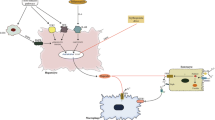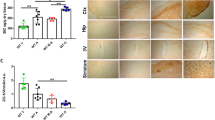Abstract
Brain iron homeostasis is maintained by a balance of both iron uptake and release, and accumulating evidence has revealed that brain iron concentrations increase with aging. Hepcidin, an iron regulatory hormone produced by hepatocytes in response to inflammatory stimuli, iron, and hypoxia, has been shown to be the long-sought hormone responsible for the regulation of body iron balance and recycling in mammals. In this study, we report that hepcidin is widely expressed in the murine brain. In cerebral cortex, hippocampus and striatum, hepcidin mRNA levels increased with aging. Injection of hepcidin into the lateral cerebral ventricle resulted in decreased Fpn1 protein levels in cerebral cortex, hippocampus, and striatum. Additionally, treatment of primary cultured neurons with hepcidin caused decreased neuronal iron release and Fpn1 protein levels. Together, our data provide further evidence that hepcidin may be involved in the regulation of brain iron metabolism.








Similar content being viewed by others
References
Chang YZ, Qian ZM, Wang K, Zhu L, Yang XD, Du JR, Jiang L, Ho KP, Wang Q, Ke Y (2005) Effects of development and iron status on ceruloplasmin expression in rat brain. J Cell Physiol 204:623–631
Ke Y, Chang YZ, Duan XL, Du JR, Zhu L, Wang K, Yang XD, Ho KP, Qian ZM (2005) Age-dependent and iron-independent expression of two mRNA isoforms of divalent metal transporter 1 in rat brain. Neurobiol Aging 26:739–748
Jellinger KA (1999) The role of iron in neurodegeneration: prospects for pharmacotherapy of Parkinson’s disease. Drugs Aging 14:115–140
Bishop GM, Robinson SR, Liu Q, Perry G, Atwood CS, Smith MA (2002) Iron: a pathological mediator of Alzheimer disease? Dev Neurosci 24:184–187
De Domenico I, Vaughn MB, Yoon D, Kushner JP, Ward DM, Kaplan J (2007) Zebrafish as a model for defining the functional impact of mammalian ferroportin mutations. Blood 110:3780–3783
Chang YZ, Ke Y, Du JR, Halpern GM, Ho KP, Zhu L, Gu XS, Xu YJ, Wang Q, Li LZ, Wang CY, Qian ZM (2006) Increased divalent metal transporter 1 expression might be associated with the neurotoxicity of l-DOPA. Mol Pharmacol 69:968–974
Richardson DR (1999) Role of ceruloplasmin and ascorbate in cellular iron release. J Lab Clin Med 134:454–465
Chang YZ, Qian ZM, Du JR, Zhu L, Xu Y, Li LZ, Wang CY, Wang Q, Ge XH, Ho KP, Niu L, Ke Y (2007) Ceruloplasmin expression and its role in iron transport in C6 cells. Neurochem Int 50:726–733
Mukhopadhyay CK, Attieh ZK, Fox PL (1998) Role of ceruloplasmin in cellular iron uptake. Science 279:714–717
Qian ZM, Ke Y (2001) Rethinking the role of ceruloplasmin in brain iron metabolism. Brain Res Brain Res Rev 35:287–294
Xie JX, Tsoi YK, Chang YZ, Ke Y, Qian ZM (2002) Effects of ferroxidase activity and species on ceruloplasmin mediated iron uptake by BT325 cells. Brain Res Mol Brain Res 99:12–16
Chen Y, Qian ZM, Du J, Duan X, Chang Y, Wang Q, Wang C, Ma YM, Xu Y, Li L, Ke Y (2005) Iron loading inhibits ferroportin1 expression in PC12 cells. Neurochem Int 47:507–513
Aguirre P, Mena N, Tapia V, Arredondo M, Nunez MT (2005) Iron homeostasis in neuronal cells: a role for IREG1. BMC Neurosci 6:3
Park CH, Valore EV, Waring AJ, Ganz T (2001) Hepcidin, a urinary antimicrobial peptide synthesized in the liver. J Biol Chem 276:7806–7810
Viatte L, Lesbordes-Brion JC, Lou DQ, Bennoun M, Nicolas G, Kahn A, Canonne-Hergaux F, Vaulont S (2005) Deregulation of proteins involved in iron metabolism in hepcidin-deficient mice. Blood 105:4861–4864
Pigeon C, Ilyin G, Courselaud B, Leroyer P, Turlin B, Brissot P, Loreal O (2001) A new mouse liver-specific gene, encoding a protein homologous to human antimicrobial peptide hepcidin, is overexpressed during iron overload. J Biol Chem 276:7811–7819
Nicolas G, Chauvet C, Viatte L, Danan JL, Bigard X, Devaux I, Beaumont C, Kahn A, Vaulont S (2002) The gene encoding the iron regulatory peptide hepcidin is regulated by anemia, hypoxia, and inflammation. J Clin Invest 110:1037–1044
Nicolas G, Bennoun M, Devaux I, Beaumont C, Grandchamp B, Kahn A, Vaulont S (2001) Lack of hepcidin gene expression and severe tissue iron overload in upstream stimulatory factor 2 (USF2) knockout mice. Proc Natl Acad Sci USA 98:8780–8785
Lou DQ, Nicolas G, Lesbordes JC, Viatte L, Grimber G, Szajnert MF, Kahn A, Vaulont S (2004) Functional differences between hepcidin 1 and 2 in transgenic mice. Blood 103:2816–2821
Nemeth E, Tuttle MS, Powelson J, Vaughn MB, Donovan A, Ward DM, Ganz T, Kaplan J (2004) Hepcidin regulates cellular iron efflux by binding to ferroportin and inducing its internalization. Science 306:2090–2093
Zechel S, Huber-Wittmer K, und Halbach O (2006) Distribution of the iron-regulating protein hepcidin in the murine central nervous system. J Neurosci Res 84:790–800
Clardy SL, Wang X, Boyer PJ, Earley CJ, Allen RP, Connor JR (2006) Is ferroportin–hepcidin signaling altered in restless legs syndrome? J Neurol Sci 247:173–179
Nicolas G, Bennoun M, Porteu A, Mativet S, Beaumont C, Grandchamp B, Sirito M, Sawadogo M, Kahn A, Vaulont S (2002) Severe iron deficiency anemia in transgenic mice expressing liver hepcidin. Proc Natl Acad Sci USA 99:4596–4601
De Domenico I, Nemeth E, Nelson JM, Phillips JD, Ajioka RS, Kay MS, Kushner JP, Ganz T, Ward DM, Kaplan J (2008) The hepcidin-binding site on ferroportin is evolutionarily conserved. Cell Metab 8:146–156
Nemeth E, Preza GC, Jung CL, Kaplan J, Waring AJ, Ganz T (2006) The N-terminus of hepcidin is essential for its interaction with ferroportin: structure–function study. Blood 107:328–333
Peyssonnaux C, Zinkernagel AS, Datta V, Lauth X, Johnson RS, Nizet V (2006) TLR4-dependent hepcidin expression by myeloid cells in response to bacterial pathogens. Blood 107:3727–3732
Wang Q, Du F, Qian ZM, Ge XH, Zhu L, Yung WH, Yang L, Ke Y (2008) Lipopolysaccharide induces a significant increase in expression of iron regulatory hormone hepcidin in the cortex and substantia nigra in rat brain. Endocrinology 149:3920–3925
Dallalio G, Fleury T, Means RT (2003) Serum hepcidin in clinical specimens. Br J Haematol 122:996–1000
Masaki T, Yoshimatsu H, Chiba S, Watanabe T, Sakata T (2001) Central infusion of histamine reduces fat accumulation and upregulates UCP family in leptin-resistant obese mice. Diabetes 50:376–384
Rodriguez A, Pan P, Parkkila S (2007) Expression studies of neogenin and its ligand hemojuvelin in mouse tissues. J Histochem Cytochem 55:85–96
Theurl I, Ludwiczek S, Eller P, Seifert M, Artner E, Brunner P, Weiss G (2005) Pathways for the regulation of body iron homeostasis in response to experimental iron overload. J Hepatol 43:711–719
Kong WN, Zhao SE, Duan XL, Yang Z, Qian ZM, Chang YZ (2008) Decreased DMT1 and increased ferroportin 1 expression is the mechanisms of reduced iron retention in macrophages by erythropoietin in rats. J Cell Biochem 104:629–641
Kong WN, Chang YZ, Wang SM, Zhai XL, Shang JX, Li LX, Duan XL (2008) Effect of erythropoietin on hepcidin, DMT1 with IRE, and hephaestin gene expression in duodenum of rats. J Gastroenterol 43:136–143
Nagasawa K, Aoki H, Yasuda E, Nagai K, Shimohama S, Fujimoto S (2004) Possible involvement of group I mGluRs in neuroprotective effect of theanine. Biochem Biophys Res Commun 320:116–122
Kulaksiz H, Theilig F, Bachmann S, Gehrke SG, Rost D, Janetzko A, Cetin Y, Stremmel W (2005) The iron-regulatory peptide hormone hepcidin: expression and cellular localization in the mammalian kidney. J Endocrinol 184:361–370
Floyd RA, Carney JM (1993) The role of metal ions in oxidative processes and aging. Toxicol Ind Health 9:197–214
Morris CM, Candy JM, Oakley AE, Bloxham CA, Edwardson JA (1992) Histochemical distribution of non-haem iron in the human brain. Acta Anat (Basel) 144:235–257
Ke Y, Ming Qian Z (2003) Iron misregulation in the brain: a primary cause of neurodegenerative disorders. Lancet Neurol 2:246–253
Abboud S, Haile DJ (2000) A novel mammalian iron-regulated protein involved in intracellular iron metabolism. J Biol Chem 275:19906–19912
Donovan A, Brownlie A, Zhou Y, Shepard J, Pratt SJ, Moynihan J, Paw BH, Drejer A, Barut B, Zapata A, Law TC, Brugnara C, Lux SE, Pinkus GS, Pinkus JL, Kingsley PD, Palis J, Fleming MD, Andrews NC, Zon LI (2000) Positional cloning of zebrafish ferroportin1 identifies a conserved vertebrate iron exporter. Nature 403:776–781
McKie AT, Marciani P, Rolfs A, Brennan K, Wehr K, Barrow D, Miret S, Bomford A, Peters TJ, Farzaneh F, Hediger MA, Hentze MW, Simpson RJ (2000) A novel duodenal iron-regulated transporter, IREG1, implicated in the basolateral transfer of iron to the circulation. Mol Cell 5:299–309
Jiang DH, Ke Y, Cheng YZ, Ho KP, Qian ZM (2002) Distribution of ferroportin1 protein in different regions of developing rat brain. Dev Neurosci 24:94–98
Wu LJ, Leenders AG, Cooperman S, Meyron-Holtz E, Smith S, Land W, Tsai RY, Berger UV, Sheng ZH, Rouault TA (2004) Expression of the iron transporter ferroportin in synaptic vesicles and the blood–brain barrier. Brain Res 1001:108–117
De Domenico I, Ward DM, di Patti MC, Jeong SY, David S, Musci G, Kaplan J (2007) Ferroxidase activity is required for the stability of cell surface ferroportin in cells expressing GPI-ceruloplasmin. EMBO J 26:2823–2831
Jeong SY, David S (2003) Glycosylphosphatidylinositol-anchored ceruloplasmin is required for iron efflux from cells in the central nervous system. J Biol Chem 278:27144–27148
Qian ZM, Shen X (2001) Brain iron transport and neurodegeneration. Trends Mol Med 7:103–108
Zecca L, Youdim MB, Riederer P, Connor JR, Crichton RR (2004) Iron, brain ageing and neurodegenerative disorders. Nat Rev Neurosci 5:863–873
Roskams AJ, Connor JR (1994) Iron, transferrin, and ferritin in the rat brain during development and aging. J Neurochem 63:709–716
Pinero DJ, Li NQ, Connor JR, Beard JL (2000) Variations in dietary iron alter brain iron metabolism in developing rats. J Nutr 130:254–263
Connor JR, Boyer PJ, Menzies SL, Dellinger B, Allen RP, Ondo WG, Earley CJ (2003) Neuropathological examination suggests impaired brain iron acquisition in restless legs syndrome. Neurology 61:304–309
Allen RP, Barker PB, Wehrl F, Song HK, Earley CJ (2001) MRI measurement of brain iron in patients with restless legs syndrome. Neurology 56:263–265
Liu XB, Yang F, Haile DJ (2005) Functional consequences of ferroportin 1 mutations. Blood Cells Mol Dis 35:33–46
Liu XB, Nguyen NB, Marquess KD, Yang F, Haile DJ (2005) Regulation of hepcidin and ferroportin expression by lipopolysaccharide in splenic macrophages. Blood Cells Mol Dis 35:47–56
Acknowledgments
This work was supported by National Natural Sciences Foundation of China (30570957, 30871260) and Natural Science Foundation of Hebei Province (C2007000251).
Author information
Authors and Affiliations
Corresponding author
Additional information
S.-M. Wang and L.-J. Fu contributed equally to this manuscript.
Rights and permissions
About this article
Cite this article
Wang, SM., Fu, LJ., Duan, XL. et al. Role of hepcidin in murine brain iron metabolism. Cell. Mol. Life Sci. 67, 123–133 (2010). https://doi.org/10.1007/s00018-009-0167-3
Received:
Revised:
Accepted:
Published:
Issue Date:
DOI: https://doi.org/10.1007/s00018-009-0167-3




